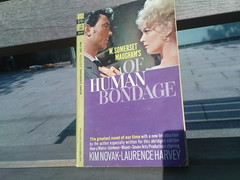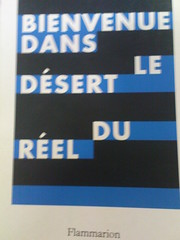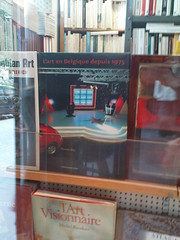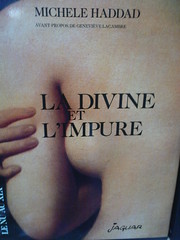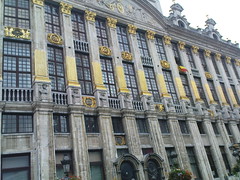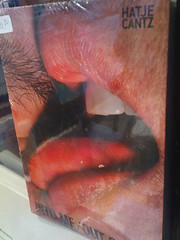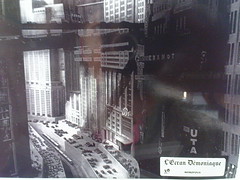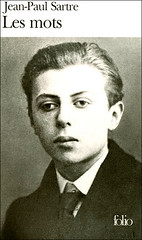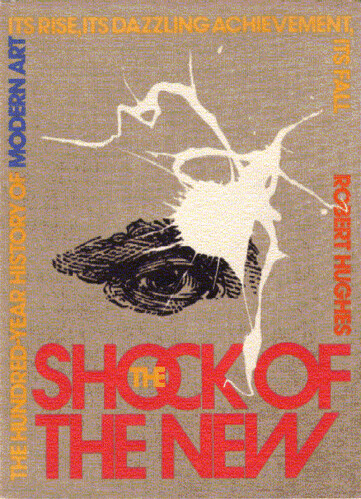Category Archives: life
Romy Schneider @ 70 and spiked fences
A tribute to Romy Schneider.
Music by Eric Satie, “Gnossienne No. 5,” played by Pascal Rogé
You are very young and it is a Sunday afternoon. Your parents pass off one of the films in the Sissi trilogy to you as a guilty pleasure.
The “spiked fence” scene is at 4:27
You’re older now. You see a spiked fence in the Hitchcock/Dali film Spellbound. You are – of course – unaware of the Dali connection.
You’re seventeen. Your mother tells you the sad story of Romy Schneider who killed herself after her son David-Christopher had accidentally been killed by trying to climb over a spiked fence.
The”spiked fence” scene is at 2:38
Still older. The spiked fence again. This time in The Virgin Suicides.
Romy Schneider would have been 70 today. Her son 41. Click the images to see the YouTube footage.
Sitting on a bench in Antwerp
My copy of “Of Human Bondage,” sitting on a bench in Antwerp.
I was recently very irked by a series of posts[1] over at the Anglophone blog Gatochy (known for its excellent image juxtapositions). The posts were about sexual masochism and she painted a ridiculously malinformed picture of the sexual masochist as a person suffering from a mental disorder. When I reacted by guiding her gently towards Zizek‘s Enjoy Your Symptom! she graciously acknowledged to never having heard of him. After an exchange of about 3 comments she proposed to never speak to me again, to which I proposed to oblige, but first pointing her to and quoting from the relevant Wikipedia article which shows that masochism, just like homosexuality is no longer considered a mental disorder.
The results of newer studies have led to calls to abolish sadism and masochism as disease categories completely, arguing that the truly pathological forms are adequately covered by other diagnoses. The sadomasochistic subculture added a political dimension to this drive with claims of discrimination and by pointing to the precedent of removing of homosexuality from the list of mental disorders.
In response, the American Psychiatric Association modified the criteria for sadism and masochism in the Diagnostic and Statistical Manual of Mental Disorders (DSM IV) in 1994 so that consensual sadomasochistic behavior alone is not considered a sexual disorder anymore. In the DSM-IV TR, published in 2000, sadomasochistic behavior can be diagnosed if the patient “has acted on these urges with a non-consenting person” or “the urges, sexual fantasies, or behaviors cause marked distress or interpersonal difficulty,” so consensual sadomasochism can no longer be considered a disease unless it causes severe discomfort. In 1995, Denmark became the first country to completely remove sadomasochism from its classification of diseases.
Our entire conversation – and the comment above – was promptly erased by the author Marianna and I was doubly annoyed. I thought I had done her a favor by showing her the errors of her ways. I dedicate the photograph above to her. May she soon awaken from her obstinate ignorance.
Impressions of Antwerp #1
Your impressions, Brussels
The hightest point of Brussels – or so it seems – is the Law Court. It’s a good place to park your car. It’s free and there is a somewhat surreal elevator to the city.
In Brussels, there is a small arcade not far from the Grand Place and the Royal Galleries of Saint-Hubert, where new and second hand books are sold. You photograph L’art en Belgique depuis 1975, La Divine et l’impure, Welcome to the Desert of the Real, Amours, guerre et sexualité, Philippe Garner‘s (you presume) Decorative Arts from 1940 to the Present Day (originally London, 1980) with cult brand Fiorucci on the cover.
Entering the Royal Galleries of Saint-Hubert from The Grand Place side, you follow the arcade until after the intersection, on the corner is art book shop Librairie Saint-Hubert, where you photograph Into Me / Out of Me (Klaus Biesenbach, Georges Bataille and Susan Sontag) [1].
Continuing, you take some shots of the ongoing Écran Total repertory programme from Cinéma Arenberg.
By now it has started raining, this is what you see at the Regentschapsstraat, on your way back to the car, holding a piece of cardboard over your head.
Bertrand Russell’s bad breath and Wittgenstein’s repressed sexuality
Les Mots by Sartre
I bought and read Eco’s On Ugliness last Christmas, and a couple of days ago, a Sartre quote collected in that book resurfaced. The quote was taken from Sartre’s autobiography The Words and considers the smells of his childhood; the pleasant odors of women and the unpleasant but more serious odors of men. And then the bad breath of his schoolmaster which Sartre relished as the odor of learning and virtue.
I decided to investigate and Googling for Sartre and bad breath brings up The Great Unwashed[1], an article by Wendy Doniger O’Flaherty:
- “…Russell had such bad breath that Lady Ottoline Morrell refused to sleep with him for a while. Sartre was disgustingly dirty, and Connolly, left bathroom detritus in the bottom of his host’s grandfather clock ”
Etymologically attributed to Edmund Burke, the great unwashed is a phrase used to denote the populace, particularly the working class.
But here Doniger refers to the book Intellectuals by Paul Johnson which investigates the personal lives of philosophers and authors such as Rousseau, Shelley, Marx, Ibsen, Tolstoy, Hemingway, Brecht, Bertrand Russell, Sartre and Edmund Wilson, to name but a few.
Sartre, Connolly and Russell’s peculiarities remind me of toilet philosophy and embodied philosophies, but also calls into question the supposed gap between art and life (i.e. the space where Robert Rauschenberg liked to work) and the conflicting views of the New Critics and later the neoformalists who wish to excise all autobiographical details from philosophical arguments; vs the hermeneutic and Freudian approaches, which dare to augment the text with its paratext.
I am all for the latter interpretive methods (also because of the prevalence of the former in Anglo-American philosophy), a key factor in this conviction was Colin Wilson‘s reading of Wittgenstein‘s philosophy in The Outsider. Conventional sources will point you to the Heidegger / nazism debacle, but the Wittgenstein example is much more enlightening because Wilson links Wittgenstein’s homosexuality with his reluctance to speak the unspeakable and his eventual arrival at the maxim in the Tractatus:
- “What can be said at all can be said clearly; and what we cannot talk about we must pass over in silence.”
This phrase rendered Wittgenstein famous but is due to his repressed sexuality argues Wilson via Bartley.
- “Bartley‘s comment [on Wittgenstein’s homosexuality] help us to understand Wittgenstein’s attitude to philosophy. Wittgenstein possessed the disposition that is often found in saints and ascetics: a powerful craving for meaning and purpose, and immense self-disgust at his own failure to find them. […] It was this sense of failure, of living on the brink of an abyss, that produced in Wittgenstein the craving for certainty that led him to create the philosophical system of the Tractatus.” —Colin Wilson via The Misfits
and
- “[In the Tractatus], Wittgenstein was led to define truth as tautology – a mere repetition of the same meaning. […] Wittgenstein agrees that there is such a thing as religious truth and ethical truth. But he insists that it cannot be put into words, and that any philosopher who thinks he is talking about these great universal truths is merely deceiving himself. —Colin Wilson via The Misfits
Happy birthday Mr. Roeg
Nicolas Roeg turns 80 today. He made his best creative work before 1986. Castaway was his last great film and he made several world cinema classics.
[Youtube=http://www.youtube.com/watch?v=6wScqqTJqYc]
White of the Eye by Donald Cammell
Instead of focusing on Roeg’s own output, I’d like you to have this[1] clip from White of the Eye by Roeg’s brother in arms Donald Cammell (Performance, (1968), Demon Seed (1977), White Of The Eye (1987) and Wild Side (1999)).
I haven’t seen White but based on the YouTube footage and Cammell’s genius I declare it WCC #57. It looks like a slasher film, it is a slasher film, but most of all, it is a Cammell film.
P. S. the clip above was posted by YouTube user Truegore[2], who hosts some other interesting clips such as Viy[3]. Viy is WCC #58.
Happy birthday Robert Hughes
Australian writer and art critic Robert Hughes turns 70 today. Congrats Robert, and thanks for The Fatal Shore (the history book on Australia) and The Shock of the New, a well-reputed modern art history book I only managed to be lukewarm about, when I read it some time in 2006. Too much attention for Cezanne (I’ve never taken to him, from my “dilettante” perspective), and Hughes fails to mention the influence of photography and illustrated newspapers on Impressionism.
To give you an idea of Hughes’s art criticism, here are his insights on Equivalent VIII, a work by Carl Andre:
“The essential difference between a sculpture like Andre‘s Equivalent VIII[1], 1978, and any that had existed before in the past is that Andre’s array of bricks depends not just partly, but entirely, on the museum for its context. A Rodin in a parking lot is still a misplaced Rodin; Andre’s bricks in the same place can only be a pile of bricks.”–The Shock of the New, Robert Hughes.
‘Sumptuary moments’ are revolutionary in themselves
Unidentified gold toilet
This is my third post on Georges Bataille‘s general economy. The first was here[1], the second here[2].
This post consists of a quote by the designer Nic Hughes I believe, author of the blog Haunted Geographies.[3]. Yes. Haunted. As in hauntology.
- “In ‘The notion of expenditure’ Georges Bataille concentrates on the more destructive expressions of potlatch, specifically ‘non-productive expenditure’- the type of ‘Killing wealth’ only rarely experienced these days. For instance, the KLF’s burning of a million pounds[4] or Ryoei Saito’s cremation[5] of 160 million dollars of fine art. For Bataille, ‘sumptuary moments’ are revolutionary in themselves, purely because they are the antithesis of use. Games, war, spectacle, art, non-reproductive sex, all challenge the tyranny of utility. They ‘represent activities which, at least in primitive circumstances, have no end beyond themselves’ (Bataille, 2004, p118). Later he spins off on a more Nietzschean tact, extending the metaphor to genocide and the destruction of a whole class- the power elite potlatch.” –Nic Hughes at Haunted Geographies [6]
Thurston Moore @50
Thurston Moore of Sonic Youth turns 50 today.
[Youtube=http://www.youtube.com/watch?v=tvAta5i4lFs&]
Thurston Moore on meeting American punk icon Mike Watt (Minutemen and fIREHOSE)
Youtube clip from a deleted scene from the We Jam Econo (2006) documentary. Date of interview shown unknown.











